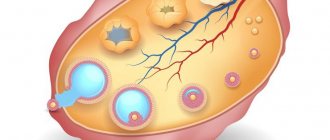Menstrual irregularities in adolescents
Quite often, in more than 50% of cases, a teenager experiences a delay in menstruation or its complete absence (amenorrhea).
Oligomenorrhea – the duration of the menstrual cycle in girls is more than 35 days.
Amenorrhea is the absence of menstruation for more than 6 months. This disorder can be either primary or secondary. Amenorrhea is considered primary when a teenager under 16 years of age has never had a period. A disorder of the menstrual cycle is considered secondary when a girl does not have her next menstruation at a certain moment, although before that the cycle was regular.
Juvenile bleeding is massive bleeding from the vagina that lasts longer than a week and is accompanied by symptoms of anemia (dizziness, pallor, weakness, low blood pressure). Often such bleeding occurs after a long delay.
Oligomenorrhea is most often diagnosed. But it is worth remembering that all types of cycle disorders can lead to serious consequences (infertility) if you do not pay due attention to the problem that has arisen in time. But it is also worth considering that young girls during the formation of the menstrual cycle may have minor disruptions that do not require medical intervention, which should not be regular and long-lasting. Otherwise, all these abnormalities may indicate a problem in reproductive health.
Reasons for long absence
In most cases, delayed menstruation in girls is normal. As well as the fact that they do not begin until the age of fifteen. But you need to understand why a delay in menstruation at 14 years old can signal certain violations. In particular, this may be caused by the stress that many adolescents are exposed to, excessive stress, poor diet, developmental characteristics and other factors.
For example, the cycle may be disrupted due to hypothermia of the genitals or infections (it is known that teenagers are negligent about hygiene or insulation in the cold season; some girls want to surprise their friends with beautiful outfits in winter, but at the same time they suffer from the cold). Others, trying to imitate celebrities or girlfriends, go on exhausting diets to lose weight, which at this age are dangerous to health. Changes in the body that may occur against this background will concern not only the delay or absence of menstruation, but can also lead to irreversible consequences.
The task of parents during this period is not only to control the regularity of the girl’s menstrual cycle, but also to monitor other areas of her life, since everything can be interconnected.
Possible diseases
A delay in menstruation may indicate the presence of a particular disease. To find out, you need to pay attention to the accompanying symptoms and go to see a doctor. Irregularity of the cycle can be influenced by:
- colds;
- vegetative-vascular dystonia;
- chronic tonsillitis;
- hormonal disorders;
- infectious diseases;
- diseases of the endocrine system and more.
You definitely need to watch how your periods go in the first years. If a girl suffers from a severe headache during this period, faints, complains of nausea and severe pain in the lower abdomen, then it is better to consult a gynecologist. A short or very long period of discharge should also raise suspicion.
Features of development
Of course, each child has his own individual characteristics. But parents must be able to distinguish them from developmental disorders. Girls begin puberty at approximately 8-10 years of age. At this time, they are actively growing, and the breasts are also noticeably enlarged, hair appears in the armpits and pubic area. Maturation lasts approximately 5 years, and it is at this time that menstruation begins.
Usually by the age of 16 it is completed. And if by this age menstruation has not begun, then this indicates a developmental disorder that requires treatment. We are talking about situations where before there was no bleeding at all. In such cases, you should definitely see a doctor; in the future, such a violation may negatively affect the woman’s reproductive function.
Poor nutrition
Some young girls, completely beyond their age, begin to get involved in diets. This is absolutely impossible to do, because if the growing body does not receive sufficient quantities of the necessary vitamins and microelements, this will lead to a delay in menstruation. If they didn’t exist before, they may not start for a long time, and this also threatens with other dangerous consequences.
It is recommended to follow the following nutritional rules:
- give up snacks and limit yourself to fast food;
- eat more lean meat and fish;
- eat 5 times a day in small portions;
- the diet should include vitamins;
- regularly eat fresh vegetables and fruits;
- the temperature of hot dishes should be no more than 55 degrees, and cold ones - 15 degrees, respectively.
You also need to take a general blood test on a regular basis. This will allow you to control indicators such as hemoglobin, sugar and much more. Their lack can cause delays in the menstrual cycle. To normalize it, the doctor may prescribe folic acid and iron.
Other factors
For teenagers - both boys and girls - playing sports is very important. But you can't overdo it here. The optimal practice rate is once a week. It is prohibited to lift heavy objects or abuse loads. The bleeding may be excessive. During menstruation, girls are not recommended to attend physical education classes.
The restructuring of the body is inextricably linked with the psycho-emotional sphere. This often manifests itself in symptoms such as:
- personal experiences;
- stress;
- conflicts;
- severe fatigue.
All this can cause menstrual irregularities. It is better for parents not to disturb their children or provoke them again. It is also recommended to follow a daily routine. In order for the body to recover, you need to sleep 10 hours a day.
When menstruation occurs, a child may be worried about hormonal imbalance. This occurs due to genetic characteristics and the presence of diseases. If you do not pay attention to this and do not treat it, there may be diseases of the reproductive system in the future.
Causes of irregular periods
The main cause of irregular periods is hormonal instability in adolescents, associated with imperfect systems in the body. There are also a number of provoking factors that affect hormonal balance:
- hereditary predisposition, problems with the menstrual cycle can be inherited from mother or grandmother;
- bad ecology;
- poor nutrition;
- strict diets, anorexia;
- excess body weight;
- mental overload, stressful situations at home and at school;
- lack of good rest, constant intense physical activity;
- acclimatization.
The etiology of this problem may lie not only in hormonal disorders, but also in the presence of a pathological process in a young body:
- ovarian diseases;
- infections of the reproductive system (HPV, chlamydia, etc.) can cause bleeding;
- endometriosis;
- chronic endometritis;
- pathology of the pituitary gland, TBI (traumatic brain injury).
If the cause of menstrual irregularities in girls is physiological changes associated with growing up, then no special treatment will be required. You just need to pay special attention to predisposing factors and, if possible, eliminate them. In all other cases, consultation and thorough examination are required to identify the cause and prescribe adequate treatment.
Types and signs
Puberty is a stepwise process. At the first stage, the girl’s mammary glands begin to change (the areolar area swells and darkens). After this, hair appears in the genital area and armpits, and leucorrhoea begins to be discharged from the genital tract. In parallel with this, the child’s psyche, the perception of others, etc. change. The final stage of puberty is the establishment of menstrual function.
Normally, a girl’s first period should begin no earlier than 9, but no later than 16 years. Also, these parameters may shift slightly due to constitutional and national characteristics.
In the case when there are no periods after reaching the age of 16, we should talk about primary amenorrhea. There are many reasons for the development of this condition - from developmental defects to pathology of the central nervous system.
It is important to know that over the course of two years from the beginning of menstrual function, a girl may experience various irregularities in the menstrual cycle; the frequency of 21 to 35 days and the normal duration of critical days is not always immediately established - up to 3 - 5 days. Both delays and shortening of the period are possible - the body gets used to new conditions. But any such disruptions should not be present after two years from the onset of menarche.
Alarms
If a girl begins puberty and menstruation appears, then the mother needs to monitor the frequency and nature of the discharge. Isolated violations within a year to a year and a half after the start of menstruation can be considered the norm. However, you should know the so-called warning signs, upon discovering which the girl must be taken to the doctor:
- the girl has reached the age of fifteen, and she has never had her period;
- menstruation is extremely painful, which leads to impaired activity and decreased performance of the girl;
- bleeding from the vagina lasts more than seven days;
- heavy discharge (bleeding), when frequent changes of sanitary pads are required (more than once every three hours);
- the interval between menstruation is quite long (three months or more);
- irregular periods have been observed for 12 months or more;
- intermenstrual heavy bleeding.
Delay rates for girls
The reasons for delayed periods in adolescents, if there are no pathologies, are simple: until a certain age, they do not yet occur regularly, as in adult women. But it’s still better to keep a special calendar. Typically, the cycle becomes regular two years after the first menstruation.
Normally, when the difference between cycles is up to 45 days, there is no need to worry about this. However, if menstruation disappears for several months in a row, and the discharge itself may last for 3 days or a week, then it is better to consult a doctor.
Diagnostic measures
Menstrual irregularities require careful diagnosis at any age, especially during puberty. This is due to the fact that the girl’s reproductive health is still very fragile and can be negatively affected by any changes (even the most minimal) in the young body.
When a girl consults a doctor with this problem, an integrated approach to diagnosis and treatment is necessary.
Diagnosis of irregular periods includes:
- A survey that will help clarify complaints, determine the history of the formation of the menstrual cycle (if menstruation is present) and the girl’s life history. It is necessary to identify factors that could affect hormonal levels.
- Gynecological examination to identify pathologies of the genital organs. If the girl is already sexually active, then a full vaginal examination and bimanual examination are performed. It is necessary to take swabs from the vagina, urethra and cervical canal.
- Laboratory research methods. You should take a general blood and urine test to identify hidden inflammation in the body. Smears are examined for the presence of genital tract infection. Blood must be taken to study hormonal levels (prolactin, luteinizing and follicle-stimulating hormone).
- Ultrasound examination of the pelvic organs. In order to identify pathologies of the internal genital organs.
Only after a full examination and receipt of all test results can one judge the causes of the disorders and prescribe adequate treatment.
Treatment of pathology
Treatment of amenorrhea in adolescents directly depends on the cause that caused it.
Complex therapy in some cases can restore menstrual function and even normalize reproductive potential. But some variants with genetic changes and impaired development of the genital organs sometimes require serious surgical interventions.
The main directions of conservative treatment are as follows:
- Cyclic vitamin therapy, as well as homeopathy and herbal remedies. For example, cyclodinone, time factor, ciclovita and others are often used. They are especially effective for functional disorders caused by stress, changes in diet, constitutional characteristics and in the presence of metabolic pathology, for example, diabetes, etc.
- Parents should organize the most comfortable conditions for the girl’s life: if necessary, reduce physical and mental stress, balance nutrition, etc.
- Sedatives, ranging from herbal preparations to antidepressants, help overcome functional disorders caused by anorexia and other diseases. Mental balance is important for normalizing connections between the pituitary gland, hypothalamus and genital organs. Adaptogens (eleutherococcus, ginseng and the like) are prescribed for the same purpose.
- Drugs to stimulate the own ovarian function, for example, methionine, glutamic acid and others.
- Hormone replacement therapy with conventional oral contraceptives is often prescribed on an ongoing basis. Such treatment is necessary to simulate menstrual function and maintain health in case of ovarian failure or abnormalities associated with it.
Treatment
If a teenage girl has irregular periods, this process is quite difficult to treat. The specialist must correctly select the correct treatment regimen. The body has not yet completed the formation stage and the slightest intrusion into this process can lead to serious consequences. Basically, the treatment method goes like this:
- Organizing a proper daily routine, nutrition, proper rest and limiting physical activity and emotional stress.
- Taking vitamins B and E, as well as mild sedatives.
- Prescription of hormone-containing drugs. Preparations containing progesterone and estrogen are used. However, this method is used as a last resort so as not to disrupt the girl’s puberty.
- Physiotherapeutic measures: mud therapy, magnetic therapy, balneotherapy, heliotherapy, hypoxic therapy, UHF, etc.
Irregular menstrual cycles are quite common in teenagers. If the cause of this process is identified in time and treatment is started, it will not negatively affect the reproductive system in the future. You should not hope that menstruation will return on its own; you should definitely consult a specialist.
Share:
Norm
On average, the menstrual cycle should be 21-35 days. The duration of menstruation can vary from 3 to 6 days, and at this time the release of blood is about 50-100 ml.
Before menstruation, almost every woman experiences a number of PMS symptoms: severe irritability, tearfulness, weakness, pain in the mammary glands, discomfort in the lumbar region and lower abdomen. Nevertheless, these symptoms should not unsettle a woman.
If she feels too bad, and constantly takes painkillers to relieve pain, she should consult a specialist, since these symptoms indicate the development of some pathology.
The fact is that menstruation is a normal physical process, so it should not have a detrimental effect on a woman’s life. In addition, excessively scanty or profuse bleeding is considered a pathology.










